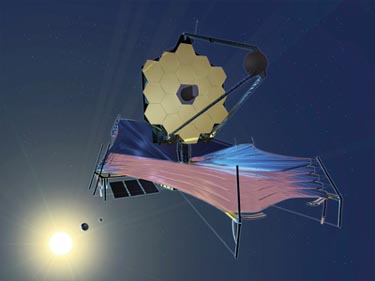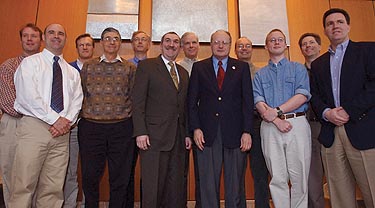

Cosmic Clues
Rochester alumni and faculty lead NASA’s effort to build a better telescope.
By Jonathan Sherwood ’04 (MA)
 |
| SKY EYE: From its perch 1 million miles away from Earth, the Webb telescope is expected to provide an unprecedented glimpse into the origins of the universe. (Artist's rendering courtesy Northrup Grumman Space Technology) |
Fast-forward half a dozen years to an orbit far, far away: 18 hexagonal segments emerge from a spacecraft and slowly align themselves to form a 20-foot beryllium mirror. About 1 million miles away, Earthbound scientists maneuver the mirror to point into the very heart of the big bang, hoping to find detailed clues of how the universe began.
For a large group of Rochester scientists—both alumni and faculty—that future scene will be the culmination of a multiyear effort to develop and launch NASA’s James Webb Space Telescope, scheduled to lift off in 2011. The new infrared telescope will replace the successful, but aging—and sometimes problem-plagued—Hubble Space Telescope.
“The Webb telescope is, quite literally, the next-generation telescope,” says Duncan Moore ’74 (PhD), the Rudolf and Hilda Kingslake Professor of Optical Engineering at Rochester. “It will go where no telescope—not even the Hubble—has gone before.”
 |
| ROCHESTER’S WEBB: Scientists with University connections who are helping to develop the Webb telescope gathered in Rochester last April. Pictured are (front row, left to right) Conrad Wells ’89, ’91 (MS); B. Roy Frieden ’66 (PhD); Duncan Moore ’74 (PhD), the Rudolf and Hilda Kingslake Professor of Optical Engineering; James Wyant ’68 (PhD); graduate student Matt Bolcar, Lee Feinberg ’87; (back row) research associate Sam Thurman ’96, ’03 (PhD); former faculty member Greg Forbes; Gary Golnick ’76 (MS); James Fienup, the Robert E. Hopkins Professor of Optics; Joseph Howard ’00 (PhD); and Tony Whitman ’88 (MS). |
Moore cochairs a group of about 65 national experts in optics and space science that is advising NASA on the telescope. About 15 members of the group, including Lee Feinberg ’87, Webb telescope manager for NASA’s Goddard Space Flight Center in Greenbelt, Maryland, are either University alumni or faculty members.
When launched, the telescope—named for James E. Webb, who ran the National Aeronautics Space Administration from 1961 to 1968—will be three times larger than the Hubble. Because of the increased light-collecting power of its larger mirror and because of its distant orbit, the Webb telescope will be able to offer an unprecedented look into the deepest reaches of the universe.
The spacecraft’s instruments also will be extraordinarily sensitive to infrared light, a key to analyzing the state of the universe within the first few hundred million years of the big bang.
That’s a glimpse into a timeframe that has eluded scientists for millennia.
Says Moore: “The project is incredibly significant not only to science, but to the greater understanding of our universe.”
Jonathan Sherwood ’04 (MA) is senior science writer for University Public Relations.
